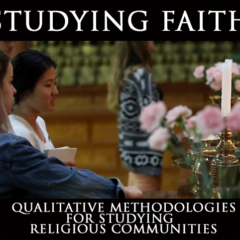Taking photography and recording audio and video can be helpful in many different ways. Looking back at your images can help you recall details that you might not have recorded in your notes. Presentations increasingly incorporate audio and visual resources as well. A paper or presentation is made all the more interesting by a great photograph or compelling clip of video.
Before you take a picture or start recording an interview or scene, be sure to ask for permission to do so. In many states, it’s against the law to record a phone call without the permission of the other party. In some instances, it may be necessary to have people sign a waiver if you plan to use the photographs for something other than a class presentation, particularly if their are children or other vulnerable people in your photos. Please consult your school or university about these rules.
If you are visiting a congregation, you may want to ask your point person or a leader about photography before you go to the event. If you cannot do so beforehand, ask an usher or anybody who appears to have some authority. In media-savvy congregations, you may have no problem taking photos without prior permission. In smaller groups, you may be able to ask the whole group or agree to take pictures only of a certain side of the room. In any case, be sure to explain how the images or recordings will be used.
Religious services are difficult places to take photography and video. Many smart phones have adequate cameras, particularly if you are taking photos for your own notes. They are also less conspicuous if you’re uncertain whether you can take photos in that environment. If you hope to use visuals in presentations, you may want to invest in a camera that allows you to shoot manually. You can also take a photography class or find resources online about how to take a good picture. Here are a few tips on getting good visuals at a religious service:
- Get out of your seat. The lighting is often difficult in places of worship. Getting closer to a brightly lit altar or stage will also help you avoid the stark contrast between light and dark areas. Walk down side aisles in order to avoid getting in the way of a service or crouch down at the front. If there’s a balcony, go up there to get a different angle.
- Zoom with your feet. Don’t just rely your camera’s zoom, but move closer to your subject. If you’re using your phone, the digital zoom can be pixelated. Your composition will improve if you get closer your subject.
- Composition: The easiest way to make your pictures look more professional is to think about the rule of thirds. If you think of a grid on a picture split into thirds both horizontally and vertically, our eyes tend to gravitate to the spots where the lines meet. Instead of centering a photo, put your subject to the left or right.
- Take a variety of pictures. Don’t just take pictures of the religious leader at the front; turn the camera around and take pictures of the congregation. Take an establishing shot of the building, a wide shot of the whole room, a medium shot of the choir and close ups of a few individuals.
- Take a lot of pictures. You may be lucky and take one amazing photo, but more often than not, you’ll realize that the photo is out of focus or the lighting or composition is off when you download it to your computer. The more pictures you take, the more likely you’ll have something you like. And the more you practice, the better you become.
Nalika Gajaweera was a senior research analyst with the USC Center for Religion and Civic Culture through 2023.
Andrew Johnson is a contributing fellow with the USC Center for Religion and Civic Culture.

